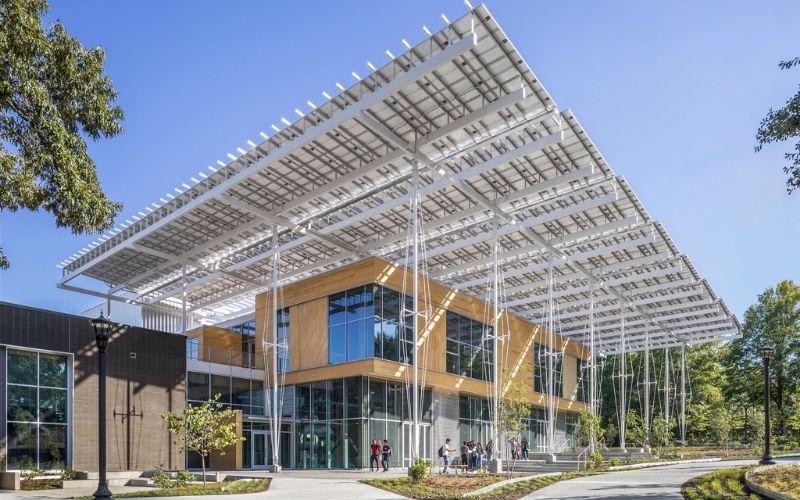Green construction: holistic concepts for sustainable building in the U.S.
The urgency to live in harmony with the environment continues to grow. It’s no longer enough to cut back: we need solutions that give back. We look at new sustainable building concepts in the U.S. with a holistic approach that protects people and the environment.

In the building industry, the approach to sustainability initially focused on reducing a structure’s footprint. Today, a shift in thinking has led to certifications and programs that ensure a building not only reduces its footprint, but also gives something back to the environment – often referred to as increasing the “handprint”. One such program in the U.S., The Living Building Challenge, provides a leading example of a holistic concept that raises the bar on sustainability in construction. We look at the evolution and details of these new standards and how elevators can play a key role.
An all-around sustainable approach
Holistic building first begins with a design that considers a space from all angles. This process involves many questions, such as: who will use it; how will it be used; how will it affect the users; how will all elements interact; and what cause and effect chains will arise? The aim is to create harmony in the space that improves the quality of living.
When applied to sustainability, a holistic building and construction concept believes that all parts of a building must contribute to greater energy efficiency, less CO2 emissions, and the elimination of toxic materials. This requires a new level of cross-disciplinary cooperation but also gives rise to systems that work together to protect inhabitants and even give back to the environment.
The Living Building Challenge

The Living Building Challenge (LBC)1 is a program in the U.S. that aims to promote total sustainability in the built environment. More aggressive than LEED (Leadership in Energy and Environmental Design), it sets tough requirements for buildings to fulfill before issuing a certificate. A growing number of projects ranging from private homes to industrial complexes are applying for LBC certification.
LBC is the world’s most rigorous green-building certification standard and for a building to meet the criteria, its design must holistically address all seven “petals” of the program: place, water, energy, health, beauty, materials, and equity.
The result is a regenerative building that is self-sufficient and draws only on resources (water, sun, and wind) located on-site. Additionally, it contains no harmful materials. The design must connect light, air, food, nature, and community and be completely harmonious with the natural environment.



A building is as energy efficient as its elevators
In a building constructed with total sustainability in mind, elevators play a key role in achieving net-zero status. For example, the cutting-edge technology and space-saving design of TWIN elevators can save up to 27% of the energy in a building.
A very good fit for the LBC standard is the regenerative drive, in which the elevator’s braking mechanism generates electricity. Another exciting step for sustainability is MULTI, the first ropeless and sideways-moving elevator for high-rise buildings. It received the Star of Energy Efficiency Award2 in the Built Environment category from the Alliance to Save Energy for its potential to radically change the way buildings consume energy and utilize space.

Materials: out with the bad, in with the good
For the LBC full certification, elevators must also pass all the tests for material health, including a regularly updated “red list” of chemical classes that are banned. As with the other building products, elevators are required to bear a Declare label, created by the International Living Future Institute. The label discloses where a product comes from, what it’s made of, and where materials go at the end of its life cycle.
The world’s first rope-free elevator for high-rise buildings – moving both vertically and horizontally.
Helping buildings make the LBC grade
TK Elevator is currently the only elevator manufacturer in the U.S. with Declare labels, starting in 2014, and contractors are turning to TK Elevator products for their reputation for materials transparency and energy-efficient innovations.
Currently, the Kendeda Building for Innovative Sustainable Design, at Georgia Tech in Atlanta is one of three buildings in the U.S. relying on TK Elevator’s energy-efficient mobility systems to help them achieve LBC certification.
The Kendeda Building, with 47,000-square-feet of programmable space, will be the first LBC certified facility in Georgia as well as the first LBC certified education and research facility in the southeast of the U.S.



From materials to buildings to cities
The LBC certification represents an evolution that can be observed across all sectors. In the fight to protect the environment for future generations, the elevator industry has seen innovations for sustainability evolve from a machinery level, and later moving up through integrated systems, and now on to holistic building and design. Mobility solutions will continue to expand into the city and urban infrastructure level, seamlessly integrating with other solutions to help achieve net-zero or, even better, net positive status.
Sources
Image Credits
The Kendeda Building, image by Jonathan Hillyer, taken from flickr
Living Building Challenge, video by International Living Future Institute, taken from youtube.com
Living Building Challenge 7 Petals, image by Palmer.olivia, taken from commons.wikimedia.org, Attribution-ShareAlike 4.0 International
